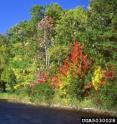Five anthropogenic factors that will radically alter northern forests in 50 years
In the most densely forested and most densely populated quadrant of the United States, forests reflect two centuries of human needs, values and practices. Disturbances associated with those needs, such as logging and clearing forests for agriculture and development, have set the stage for management issues of considerable concern today, a U.S. Forest Service study reports. The report -- Five anthropogenic factors that will radically alter forest conditions and management needs in the Northern United States -- was published recently by the journal Forest Science and is part of the Northern Forest Futures Project, an effort led by the Forest Service's Northern Research Station to forecast forest conditions over the next 50 years in the 20-state region extending from Maine to Minnesota and from Missouri to Maryland. The study is available at: http://www.nrs.fs.fed.us/pubs/45716
"In our research, we found five short- and long-term factors that will be highly influential regardless of the nature and magnitude of the effects of climate change," said lead author Stephen Shifley, a research forester with the Northern Research Station. "Addressing these issues today will make northern forests more resilient to the effects of climate change and to any other natural or anthropogenic disturbances in the long term."
The five factors identified the study are:
Northern forests lack age-class diversity and will uniformly grow old without management interventions or natural disturbances. Nearly 60 percent of northern forest land is clustered in age classes spanning 40 to 80 years; young forests (age 20 years or less) are only 8 percent of all forests in the region; and forests older than 100 years are 5 percent of forests.
The area of forest land in the North will decrease as a consequence of expanding urban areas. Cities in the 20-state region are expected to gain another 27 million people in the next 50 years and grow by about 5 million hectares.
Invasive species will alter forest density, diversity, and function. The U.S. North has the dubious distinction of having the greatest number of invasive insects and plants per county due to nearly three centuries of active commerce, diverse tree species that provide suitable habitats, and the means for invasive species to spread.
Management intensity for timber is low in Northern forests and likely to remain so. A low propensity or low capacity for forest management reduces options for addressing perceived problems such as low forest diversity, invasive species, and other insects or disease problems.
Management for non-timber objectives will gain relevance but will be challenging to implement. An unintended consequence of reduced timber harvesting may be reduced capacity to subsidize other restoration activities -- either through revenue from timber sales or through manipulation of vegetation and woody fuels during logging.
Actions that researchers and land managers can take to address these issues include: Develop quantifiable state and regional goals for forest diversity. Understand the spatial and structural impacts of urban expansion on forests. Develop symbiotic relationships among forest owners, forest managers, forest industry and the general public to support contemporary conservation goals. Work to understand the many dimensions of forest change.
"The northern quadrant of the United States includes 172 million acres of forest land and 124 million people," said Michael T. Rains, Director of the Northern Research Station and the Forest Products Laboratory. "In the next 50 years, the link between forests and economic and human health will grow. The Northern Forest Futures Project is helping identify the individual and collective steps needed to ensure healthy and resilient futures for trees and people alike."
Source: USDA Forest Service - Northern Research Station
Other sources
- Five anthropogenic factors that will radically alter northern forests in 50 yearsfrom Science DailyFri, 18 Apr 2014, 17:01:34 UTC
- Five anthropogenic factors that will radically alter northern forests in 50 yearsfrom PhysorgThu, 17 Apr 2014, 21:40:52 UTC
